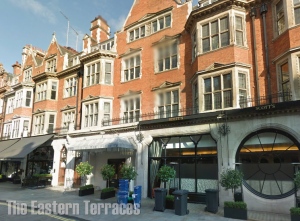
“Robert was the hippest person I ever met. Every night at 23 Mount Street there was some pop star, movie star, artist, whatever. You couldn’t keep up with that. You just had to be yourself, because you couldn’t keep up”.
Jim Dine (American Artist)
Between 1960 and 1972, Robert Fraser’s flat(s) on Mount Street were a contemporary salon for the rich, famous and talented of the 1960s. Dennis Hopper visited there, Andy Warhol went there, Keith Richards and Anita Pallenberg stayed there, Paul McCartney watched 16mm movies and tooted cocaine there, Michael Cooper and David Bailey took photos there, Donald Cammell and Kenneth Anger hustled films there, Christopher Gibbs talked art and antiques, John Paul Getty Jr. and Tara Browne were aristocratic within its confines, Allen Ginsberg, Tony Curtis, Terry Southern, William Burroughs hung out, as did Fulham footballer Bobby Keetch and Tom Wolfe.
Fraser, generally described as an aristocratic, thin dandy with a sometime stutter and an artificial aloofness, owned and ran an art gallery in nearby Duke Street Mayfair. Here, he exhibited British pop artists like Peter Blake and Richard Hamilton, and gave space to American artists such as Jim Dine, Dennis Hopper, Roy Lichtenstein and Claus Oldenberg, all the while hosting guests / potential purchasers like Marlon Brando, Marianne Faithful and members of The Rolling Stones and The Beatles. He also sponsored the 1966 exhibition by Yoko Ono at the Indica Gallery where she first met John Lennon, encouraged the Beatles to use his friend Michael Cooper to photograph the collage design of his artist Peter Blake to create the cover of Sgt Pepper’s Lonely Heart’s Club Band, and ensured that another of his artists – Richard Hamilton – designed the cover for 1968’s The Beatles.
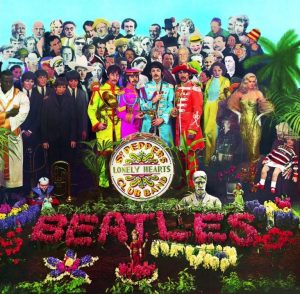
Sgt Peppers Lonely Hearts Club Band (1967) – Stolen From Web
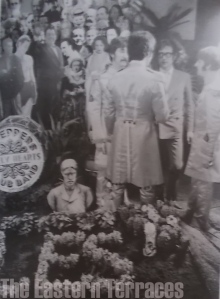
Fraser at Sgt Pepper’s Cover Shoot – Photograph by Michael Cooper
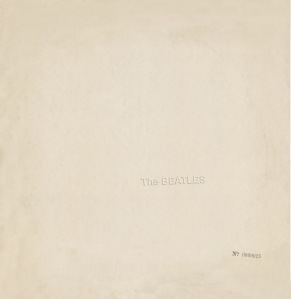
The Beatles (1968) – Stolen From Web
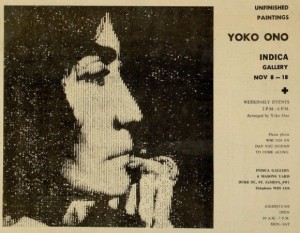
Yoko Ono Indica Gallery Exhibition Handbill (1966) – Stolen From Web
Quite often the openings at his gallery would evolve into parties at his apartment at 23 Mount Street, Mayfair. Located on the third floor of the building, above the fabled Scott’s restaurant, which had moved there in 1967, and was most recently in the news when Nigella Lawson was throttled by her then husband Charles Saatchi there in 2013, his apartment provided a refuge and a meeting place for those in the know. The apartment had a very big room, which contained an Yves Klein sculpture, a couple of chaise lounges and a bunch of cushions on the floor. Keith Richards describes it as “… full of fantastic objects. Tibetan skulls lined with silver, bones with silver caps on the end, Tiffany nouveau lamps and beautiful fabrics and textiles everywhere. He’d float around in these bright coloured silk shirts he’d brought back from India. Robert really liked to get stoned, ‘wonderful hashish’, ‘Afghani primo’. He was a weird mix of the avant-garde and old fashioned”.
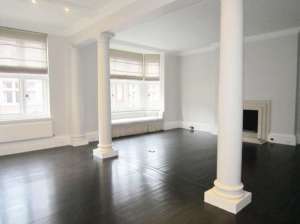
23 Mount Street (Circa 2013) – Photo Courtesy of Kenwood@Blogspot
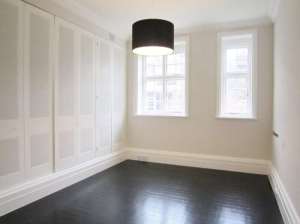
23 Mount Street (Circa 2013) – Photo Courtesy of Kenwood@Blogspot
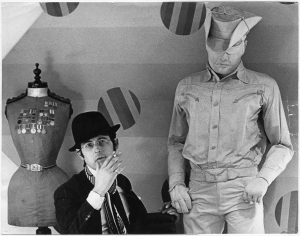
Robert Fraser At His Duke Street Gallery – Stolen From Web
Fraser having met members of the Rolling Stones at a restaurant called Mrs Beaton’s Tent, became associated with their social scene, notably Keith Richards, Mick Jagger and Brian Jones.
“He was where you went to to tell what was happening”, recollected Marianne Faithfull. “Robert was a serious conductor of lightening”.
Keith Richards remembers, “Robert was someone who owned this apartment where you’d sit around talking and now and again you’d have a chat, without really being interested that much. Ten slowly it became more and more of a friendship. Robert was never one to push… He would talk about ideas, then say, ‘Why doesn’t everybody shut up and listen to Booker T.’ Some Turkish coffee and a pipe”. Fraser liked “… his soul music, loved Indian music – was wide open on everything”.
“He’d say, ‘Come up to my place for lunch, I’ve got some new records.’ So you’d get up for it, pop around to Robert’s pad, the mint tea, nice pipe and some great new sounds. From anywhere, Morocco or Memphis”.
“You’d see Robert go from this wonderful Saville Row suit to his jellaba and his little Turkish slippers.
As Mick Jagger recalls, “He was always trying to sell me Magritte, which would have been a fantastic buy. I just didn’t have the money. If I had known they’d be worth millions I could’ve raised it. Robert was a taste guru for both bands, but Paul was someone he could sell a Magritte to”.
According to Paul McCartney, “Robert’s Flat was like a second gallery… There was no dour art talk. It was much more razzy, loose, lively discussion with him. He was the best art eye I’ve ever met”. Later Fraser would sell McCartney a Magritte painting of an apple that the Beatle’s Apple logo would be based upon.
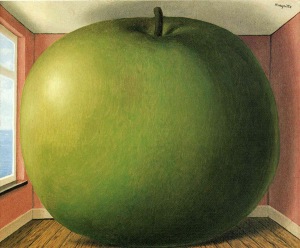
Magritte – The Listening Room (1952) – Stolen From Web
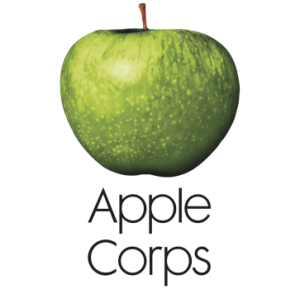
Apple Corps Logo (circa 1968) – Photo Stolen From Web
The British pop art artist Peter Blake who was exhibited by Robert notes that Mick Jagger learnt a certain sophistication from Robert Fraser by hanging about the apartment. Robert was “…very glamorous. He was handsome, incredibly well dressed. He kind of tutored them in a way”.
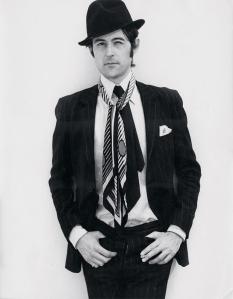
tk
Robert Fraser (Circa 1967) – Photo Stolen From Web
Chris Jagger (Mick’s brother) similarly recalls, “I remember being Robert’s flat with Jim Dine… I must have been about nineteen and I remember him having impenetrable conversations and apparently they were about scoring dope. I didn’t know what the fuck he was talking about. I wasn’t included in those conversations, I was just ‘there’. But there was a lot of hustling going on. He was very good at that.
“We all knew he was gay but he didn’t flaunt the boyfriends too much. He was homosexual but not at all camp – you’d never have known he was gay really. He was theatrical but not camp.” Mick Jagger notes, “But he was the one who invented Spanish Tony, Tony Sanchez [Keith Richards later drug dealer]. He’s a ghastly person. Why did he invent him? He did provide drugs but, but there was more than one drug dealer around.”
Paul McCartney first tried cocaine within the walls of 23 Mount Street having seen Fraser snorting lines through a rolled up pound note. McCartney himself describes that he “…felt very lucky, because he introduced me to it a year before most people were doing it. That was ’66, very early. I did a little bit with Robert, had my little phial… It didn’t seem too bad. I started to find though, I had a big problem with numbness in my throat. Some people quite like that, but occasionally I’d think that I was dying.
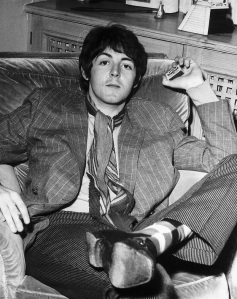
Paul McCartney (Circa 1967) – Stolen from web
Acid too made its first appearance in the lives of people in Robert’s flat as antiques dealer Christopher Gibbs remembers, “The first acid trip I ever took was around at Robert’s. There were a lot of hip Americans there – Sid Caesar, Dennis Hopper, Bruce Connor, Kenneth Anger… For all of us it was pretty nearly our first time. It was a great levelling thing, making a new camaraderie”.
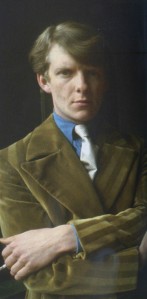
Christopher Gibbs (Circa Late 1960s) – Photo Stolen From Web
Donald Cammell was often there talking about his film ideas which turned into Performance, whilst Kenneth Anger, similarly meeting Mick and Keith there, roped Mick Jagger into making music for Lucifer Rising and filmed thensome parts of their free concert in Hyde Park to be used in his 1969 film Invocation of My Demon Brother.
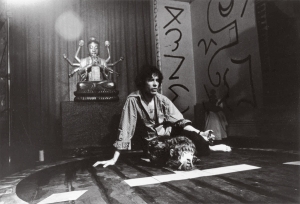
Kenneth Anger On The Set of Lucifer Rising (1970) – Photo Stolen From Web
The atmosphere of Mount Street is described by Nigel Waymouth, “You’d go round to Robert’s of an evening and you’d get stoned, but there wasn’t an awful lot said. You weren’t allowed to be nervous. Sometimes you’d get a bit restless, a bit bored, but: can I be bothered to move? The joint would cool you out. It was a great time. People would just be sitting there, listening to music, passing the joint. You felt comfortable being quiet.”
Susan Loppert, who helped run his gallery, provides the flip side to this atmosphere, “You’d go round to Mount Street and here’d be people sitting around all this awful smell of incense and grass. You could never get a drink, nobody drank anything, and they’d all be sitting around uttering these pseudo-profundities which were all rubbish! Unless you were part of it, you were completely out of it. I’ll never forget one time – he had ceramics at one point, one of Robert’s phases of collecting things, he would be continually changing his furniture around – these people were sitting around on his floor and one said, ‘Like get a hold of that red pot, man’. And everyone said, ‘Yeah, man yeah’. I’ve never forgotten that.
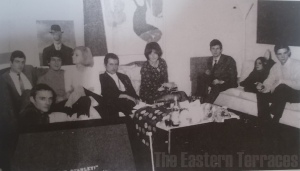
Dennis Hopper at 23 Mount Street Circa 1966 – Scan by author
Paul Trynka’s book, Sympathy for the Devil gives an account of Brian Jones being in attendance whilst messed up on Mandrax, “I was at Robert Fraser’s apartment one day, at 23 Mount Street, we were discussing what was happening, and Brian came up to see me there. And he entered through the doorway and, attempting to cross the room, he hit every piece of furniture, bouncing from one to another like a ping pong ball. It was a dreadful sight.”
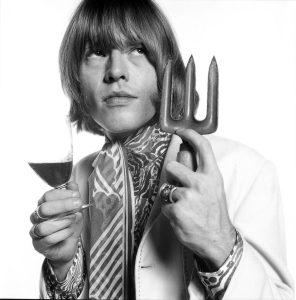
Brian Jones Reflecting Upon His Benzo Intake – Photo Stolen From Web
In May 1967 23 Mount Street hosted Andy Warhol, his acolytes and an associated swinging people to watch the interminable bore of Chelsea Girls. Fraser’s friend “Stash Klossowski” aka “Stash De Rola” aka “Prince Stanislaus Klossowski de Rola,” who was also a friend to the Rolling Stones and the Beatles, recalls bringing Paul McCartney’s 16 mm sound projector to Fraser’s flat so they could project it on two screens.
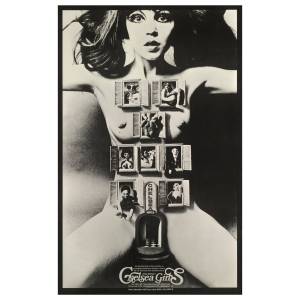
Chelsea Girls Poster – Stolen from web
“Robert called and asked me to bring Paul’s 16mm sound projector, because Chelsea Girls needed two projectors used simultaneously. So I took it over, arrived at 23 Mount Street and found about fifty or more people crammed in, lying all over the floor, all the Warhol entourage. We showed the movie and someone complained about the noise and the police came.
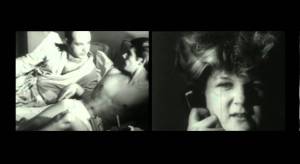
Chelsea Girls Screenshot – Stolen from web
Robert had this amazingly arrogant attitude towards the police which stopped them coming in. They tried. They were pointing to people passed out on the floor, saying, ‘Is he all right?’, but Robert just ignored this and ordered or pushed them back out on to the landing.”
Pretentious art films weren’t the only flicks shown at Robert’s flat however, as apparently Ringo Starr was fond of screening the Ray Harryhausen epic Jason and the Argonauts again and again, whilst Paul McCartney showed The Wizard of Oz on another occasion.
In 1967, Fraser, along with Keith Richards and Mick Jagger was arrested and given a prison sentence for being caught in possession of drugs at Keith Richards Country home in West Wittering.
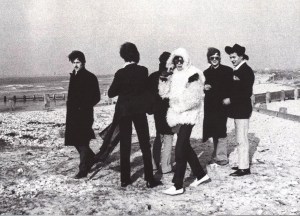
Fraser (at left) And Others On The Day of Redlands Bust – Photo From Web
He was photographed shackled with Jagger in a famous photo, which was subsequently turned into a more famous painting by one of his artists in some kind of meta play. He was sentenced to time at Wormwood Scrubs Prison with Richards, whilst Jagger was sent to Brixton Prison. According to Keith Richards, Fraser “… never lost his cool in any of those type of matters”. Unlike Richards and Jagger however, who thanks to a now famous Times newspaper editorial got off within a day or two, he did hard time, three months in all and understandably didn’t come out the same as he went in.
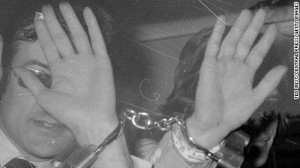
Fraser & Jagger At The Mercy Of The Law – Stolen from web
Fraser’s gallery was placed in receivership whilst he was in prison and closed permanently at the end of the decade, providing another metaphorical nail in the coffin of the 1960s. The scene makers that he hosted at his apartment however, went on to both define and outlive their era and as the lease was coming up at 23 Mount Street, Fraser took another down the road at 120 Mount Street. A larger apartment, it reportedly had lots of light, silk hangings and a four poster bed, where Keith Richards wrote You Got The Silver in the company of Anita Pallenberg, Fraser and Marianne Faithful. The lounge room was used by Keith in a similar fashion to write Gimme Shelter as he looked out the windows on to a storm outside, whilst he, Fraser, Faithful and Pallenberg got ever deeper into a heroin quagmire. According to Pallenberg who was filming the movie Performance at the time, ‘Keith and Robert were both so cynical and sarcastic, slagging of the movie [Performance] every day. “The bathroom was the most important place. First you’d shoot up, then you’d puke, then you’d feel great”.
Keith agrees, noting that, “At the time of Performance I was living in Robert’s flat in Mount Street. That film was probably the best work he ever did, except for shooting himself”.
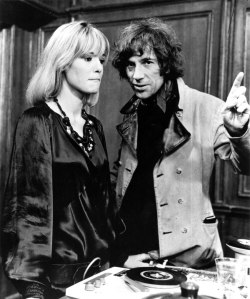
Anita Pallenberg & Donald Cammell on the Set of Performance 1968 – Stolen from web.
Indeed, the darkness that seemed to envelop the end of the 1960s was illustrated at 120 Mount Street in microcosm. While Pallenberg and cohorts shot themselves up with smack, Kenneth Anger staked a claim on this new version of Mount Street by making a temple filled with books and trinkets. In his autobiography, Richards recalls that, “Robert was into smack. He had a cupboard full of double breasted suits, all superbly made, with great fabrics, and his shirts were often handmade bespoke shirts, but the collars and cuffs were always frayed. And that was part of the look. And he used to keep spare jacks – a sixth of grain – loose in those suit pockets, so he’d always be going to the cupboard and going through all the pockets to find he odd spare jack.”
It seems prison affected Fraser for the worst, and he was noticeably grouchier and moodier in social settings afterwards. He went to India along with everybody else in 1968 but saw no recuperative affect, and following the closure of his gallery in 1969 he essentially disappeared, re-emerging almost two decades later to relaunch another gallery to reduced effect. He died in 1986 of AIDS, one of the first celebrity cases in Britain.

Written and posted by Horatio Cornblower. Copyright 2017. All rights reserved.
Unauthorized use and/or duplication of this material without express and written permission from this blog’s author and/or owner is strictly prohibited. Excerpts and links may be used, provided that full and clear credit is given to the author and The Eastern Terraces with appropriate and specific direction to the original content.
